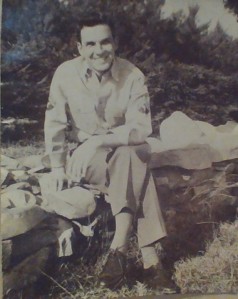The Funeral Train, now sitting on the private track siding along the Hudson River, had aready dropped off the President’s flag draped casket. A contingent of U.S. servicemen placed it onto a caisson, drawn by six chestnut brown horses, to be transported up the wood road to the Roosevelt estate at Hyde Park. It was a beautiful spring day, that early morning on April 15th, 1945. Under a mostly cloudless sky, FDR would be buried near the sundial, just inside the south entrance to the family’s Rose Garden, with its tall and thick evergreen hedge surrounding the peaceful location.
My father,  Cpl. John Paul Seekamp, was in charge of the four French 75mm Artillery guns that were positioned in the alfalfa field to the south of the large gathered crowd. There, along with the other soldier’s from West Point’s Field Artillery Detachment (“A” and “B” Batteries), the big guns, one of which would be used only in case of a misfire, would soon thunder the blank charges, presenting one volley at a time at 15 second intervals until the twenty one gun salute was complete. My father waited at the field phone for the signal to commence, as the planners wanted to wait until the caisson was halfway up the hill. It was decided to do it that way so that as the President’s casket came into view the salute would still be going on.
Cpl. John Paul Seekamp, was in charge of the four French 75mm Artillery guns that were positioned in the alfalfa field to the south of the large gathered crowd. There, along with the other soldier’s from West Point’s Field Artillery Detachment (“A” and “B” Batteries), the big guns, one of which would be used only in case of a misfire, would soon thunder the blank charges, presenting one volley at a time at 15 second intervals until the twenty one gun salute was complete. My father waited at the field phone for the signal to commence, as the planners wanted to wait until the caisson was halfway up the hill. It was decided to do it that way so that as the President’s casket came into view the salute would still be going on.
At the head of the caisson were Honor Guard riders; Ferralasco, Doty, and Matthewson. They were sergeants, also from West Point’s Field Artillery Detachment. They sat mounting the three left side horses, while the three right side horses were riderless, all six pulling the caisson. Along both sides and at the rear of the caisson walked more Honor Guards and behind all of them a West Point Buffalo soldier led a lone riderless black horse draped with a fringed black blanket, covering the animal from its hind quarters to its neck and hanging nearly to the ground. The saddle was covered by that blanket as well. In the stirrups, which were attached to the saddle through the blanket, was a pair of high black riding boots facing backwards. A sheathed saber hung from the horse’s left side and bounced off both the animal and the blanket as it walked.
Just before 10:00a.m., as the six teamed up horses had reached the halfway point coming up the hill, unfamiliar territory for them, the order was given and the first shot from the cannons was heard. Loudly. One or more of the horses spooked and bolted back, pushing the rear of the caisson toward the steep embankment, which had a drop of one hundred feet or so. As the caisson was about to roll over the edge, one of the back wheels caught a small tree. The caisson had stopped and the casket, with FDR’s body in it, remained in place. The riders and other soldiers regained control of the team and then the caisson proceeded on toward the Rose Garden, the blossoming fruit trees and soldiers, sailors, and marines standing at attention, shoulder to shoulder, lining the trail. The cannons continued sounding and soon the salute was fulfilled.
No one but the Honor Guards, the Buffalo soldier, and my father, listening to the whole episode over the field phone (and perhaps one or two of the other soldiers manning the French 75’s), knew of the near tragedy. With all the loud blasts taking place during the salute, the other’s there likely didn’t realize the slight delay, let alone the mishap. The service took place, Franklin Delano Roosevelt was buried, and Truman, members of the Supreme Court and Congress, and the rest of the dignitaries consoled Eleanor Roosevelt. That’s the part that made it into history. But of course anyone reading this now knows——what almost happened.
by John Patrick Seekamp, from the memories of my father, early 2014

An amazing story and beautifully brought to life.
LikeLike
John,
I don’t know if you are looking for feedback or not. If not, please tell me so. In the meantime: after reading this again, I think you could add a little more detail and suspense at the moment of the near disaster. As the hook of the story (and the title), it’s easy to read over it without realizing it’s the climax.
Peter
LikeLike
Hello Peter, I welcome feedback and thank you, but this is a site for presenting my finished work, a sort of sanctuary for creativity. And as for the story, it stands as I wrote it—as does all my work, with every twist, quirk and subtlety that accompanies the lot!
John
LikeLike